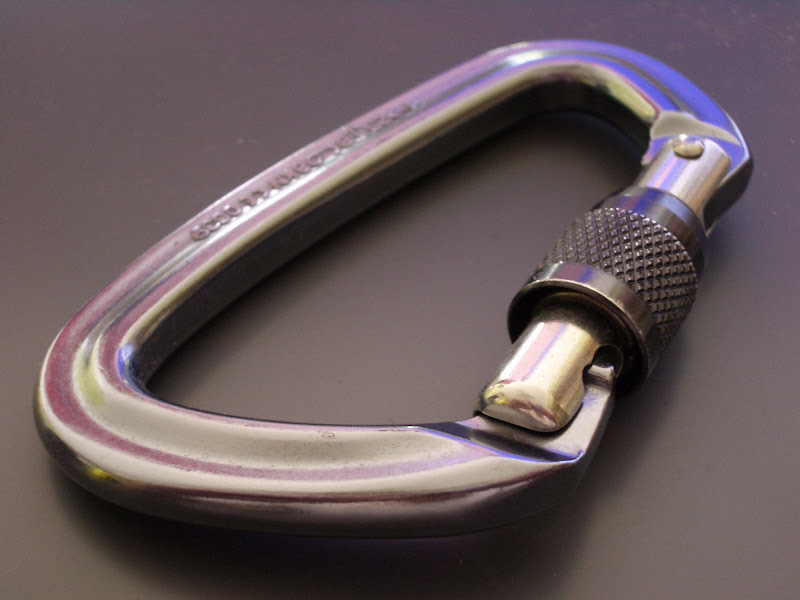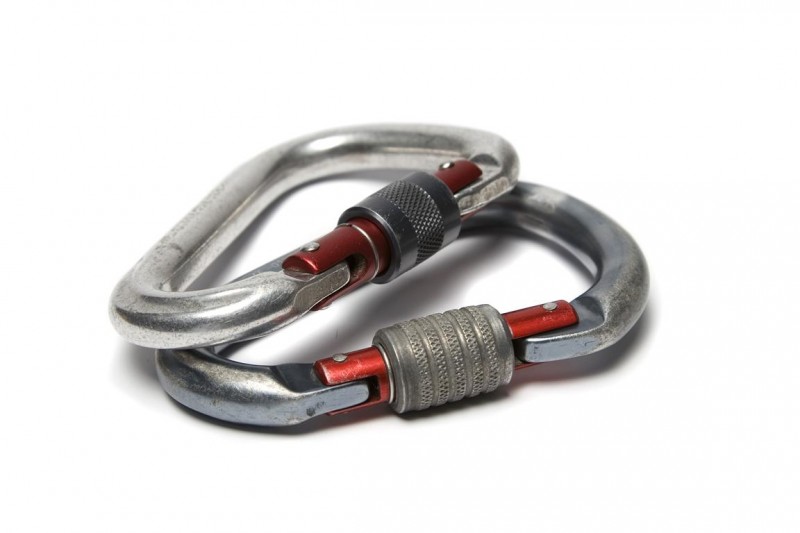How many carabiners do you carry with you while you are on the river? Enough to get you out of a tight spot? I bet not.
Many of the people I paddle with, in addition to myself, have trouble carrying enough safety gear with them on the river. There are a number of reasons for this, among them:
- Safety gear is heavy
- You use it once in a blue moon
- It’s often expensive
- “How do I make a Z-Drag again?”
When boaters are creeking, it often involves hiking with kayaks to someplace exotic and far away. Sometimes there is more hiking that boating done; however, that is part of the territory. Therein lies why we skimp on gear that we should have: We simply don’t want to carry it.
The truth is that, with the right knowledge, training, and the right gear, you can safely cut down on the amount of gear you need to take to the river without sacrificing safety.
4 Safety Things You Should Know:
- Know how to tie a prusik (if you do, you also know how to ascend a fixed rope, you just put two prussiks on a rope, attach one to yourself [harness] and up you go).
- Know how to set up a Z-Drag in under 2 minutes (Rope to boat, to anchor, to prusik; 2 carabiners, 1 stuck object, 2 prusiks, 1 throw rope, 1 rock or tree).
- Safety hardware can be vulnurable to imact damage (dropping it, chucking it to a friend below a drop, etc). Baby it.
- Hard and Soft safety gear (eg: carabiners and prusiks) are generally not friends with water. Try to keep them dry (or, at least, try to keep the soft gear dry). It’ll give you peace of mind when you are hanging off a cliff from your prusik and not wondering “Oh boy, I should have replaced this thing a long long time ago…” Old nalgene bottles are great for this.

So, how many carabiners should you have with you while boating?
That depends on your rescue knowlege; however, a safe number would be at least 5 (2 of those should be locking ‘biners). I can hear what you’re saying, “Five?!? That is a lot. I surely don’t need that many ‘biners…” The truth is, you likely will.
The Scenario:
Let’s say you are trying to exit a gorge and there is some moderate climbing involved. You are likely going to need 2-3 biners for the anchor (1-2 lockers if you are doing a correct top-rope setup), a biner for your belay device (locking), and a biner or two for your friends down below (guess what, they don’t have enough carabiners for themselves. Whodathunkit?). There are 4-5 carabiners at the drop of a hat. We’re not even thinking of hauling up boats or any other miscellaneous s&(# that needs carabiners. This scenario could be reversed for descending into a canyon.
Buy more carabiners:
In any rescue situation, carabiners seem to be in need more than anything else. If you are looking for some cheap, well-made, light carabiners, check out these Omega Wire Gate carabiners. At the time of this writing (March 2010), they were a mere $4 each. Not bad. Update: Those carabiners are currently out of stock, but a quick Google Product search reveals similar results.
I hope that helps some people and maybe encourages you to pick up a few extra carabiners at the very least. Remember to inspect your safety gear regularly. Lord knows that kayakers treat that stuff like garbage. Get on it! You could be putting your life in its hands soon.
What do I carry?
When creeking, I have (at a minimum) gear to rappel, gear to ascend (2 locking biners, 4 regular biners, 1 prusik to make a harness with, one 4′ prusik, and one 2′ prusik), a small med kit, and 1-2 more random prusiks, two safety blankets, stormproof matches, a lighter, and a throw bag. When not boating familiar rivers, I will usually bring a breakdown paddle. Note that if you don’t know how to tie a munter hitch to belay with, a belay/rappel device would be a recommended addition to this list.
That’s it for this post. Got your own safety tip? Post it in the comments section below.
Cheers,
-Adam Johnson

 After spending several weeks in Pucon, it was time to venture outside of the immediate creeking wonderland (what EG calls “Babylon”) and onto rivers farther …
After spending several weeks in Pucon, it was time to venture outside of the immediate creeking wonderland (what EG calls “Babylon”) and onto rivers farther … The Turbio is undoubtedly in my Top 5 Most Beautiful Rivers list. A small creek that flows into the valley of Pucon, the creek is …
The Turbio is undoubtedly in my Top 5 Most Beautiful Rivers list. A small creek that flows into the valley of Pucon, the creek is …
12 Comments
Great article you forgot to mention the amount of practice it takes to get good with throw bags and z drags. Many folks seem to have trouble with knots so they should go to http://www.animatedknots.com great site to learn knots and a copy of the swift water rescue manual pocket manual(4″ by 6″ fits in your pocket). I practice everyday with the bag and rope rescue is a major interest with me. Everyone that paddles rivers should take the basic swift water course and they would benefit greatly. Cheers, Keep it up, Greg
If you can’t tie a knot, tie alot. 😉
Word! I can’t tell you how many times, not only did my buddy I paddle with not have enough biners, but they are slippery little buggers when boating in the winter. I know that locking are a little bit more expensive, but leave the non-lockers on your climbing rack!
ABSOLUTELY! Only locking biners on moving water!
Great article Ada,! Thanks for writing this. Well covered and logically put.
I would add perhaps a beanie and some sort of energy bar as well for a day out, just in case it gets to the stage of having to spend the night somewhere. As a further tip, I see you’ve included matches and a lighter. Something else which is small and doesn’t add much is a small candle. You can even shave the candle down so it becomes very thin. That can make quite a difference in starting fires in damp conditions.
Cheers,
Adrian
Adrian mentioned packing a candle and energy bars. I like to pack some small, snack-size bags of Cheetos. When lit, the Cheetos go up like little torches due to the oil and corn starch. Almost any salty snack, such as Fritos or potato chips will work, but the Cheetos don’t crumble. If you don’t need the Cheetos to start a fire, you can eat them. I also like to pack dental floss. It’s a small, compact supply of strong cord that can be used to quickly construct a temporary shelter or litter. Throw in a few fish hooks and some string cheese and you may be able to catch your dinner. Oh yeah, a small bottle of hand sanitizer may come in handy. I also pack a small squeeze bottle of the sterile saline solution used for contact lenses. It’s great for flushing debris out of wounds or eyes.
Great work. I really enjoyed this. Check out some of the stuff we are doing at http://www.rescueforriverrunners.com.
Cheers,
Mike
Great post!!! Simple, to the point, and most importantly getting boaters to think about safety and what’s in their kit.
Best of days on the water,
Cate
Great post, but all of this was pretty standard when I started paddling in ’91. Additionally, anyone paddling class IV or higher should have a minimum of wilderness advanced first aid, WFR or higher (nurse, EMT, Paramedic, etc.), plus SWR training. Also, an EPI pen is an absolutely necessary addition to any wilderness med kit. And, finally, a rescue PFD W/an integral chest harness will save precious seconds when lives are at stake.
One more thing- The amount and quality of the rescue/emergency medical gear that you carry is directly related to the number of friends and acquaintances you have buried.
Great article. Not enough is ever said about this sort of stuff.
Another element to the discussion is what to carry in your PFD vs one’s boat? Too often enough, the boat with the pin kit, breakdown paddle, spare layers etc. is the boat that got away, not within reach, or didn’t come out that day. Personally, my PFD always houses a simple 2x locking biner+prussik kit and 4m loop of webbing. I replace the cord rope every year and try to keep the locking gates lubed and dry when not in use. An energy bar and small folding knife are also tucked inside keeping everything snug and streamlined.
Nice article. I would add a stern word however that throw bag rope is usually not suitable for most high load applications. Throw bags are usually wet regularly (reducing the strength), dried in the sun (UV damage) and rarely checked for integrity. Additionally, if your prussik slips it can melt the polyster rope that throw ropes are made usually made from. Same goes for a fast abseil. Further yet, the tensile strength of the floating poly rope is also usually very low. Spectre / poly ropes have become popular, but usually it is a spectre core with a poly outside – you can have the poly sheath slip with prussiks, effectively negating the spectre core. I’ve seen throw stretch 40% of its length in z-drags, so it’s also horribly inefficient.
In short, be sure the rope you take has the characteristics to deal with the forces involved for your purpose. If you’re lowering boats and throwing bags, the poly stuff is fine. But if you want a rope you can rely on, consider carrying a 20-40m length of proper rescue rope for the hard work. Heavy? Yes. Worth it? You bet.
I have found most throwbags on the market are too thin in diameter to actually work with most belay devices. I have been carrying an ATC for years (never using it) only to realize it wouldn’t work with my current throw bag anyways. Munter Hitch seems the best way to belay
Pulleys are also great to have at least 2. Making a real z-drag with biners is horribly inefficient and I think can really damage your rope.